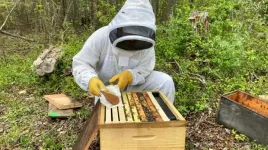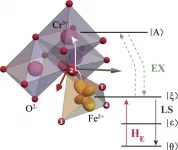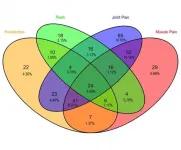(Press-News.org) MISSOULA - In bear country, it's normal to find bruins munching down on temptations left out by humans - from a backyard apple tree to leftovers in the trash bin - but these encounters can cause trouble for humans and bears alike. One method to reduce human-bear conflicts is to secure attractants like garbage and livestock feed.
While effective when implemented, this approach requires people to change their behavior, and that makes things a little more complicated.
University of Montana researchers recently published a new study in the Journal of Wildlife Management analyzing why landowners do or don't secure attractants in bear country. The results suggest that collective or socially motivated factors may be a missing and important piece of the puzzle for encouraging voluntary steps to secure attractants and improve wildlife-human coexistence. The researchers also offer suggestions for how wildlife managers might help increase these behaviors through improved messaging and outreach.
Social scientists in UM's Human Dimensions Lab, housed in UM's W. A. Franke College of Forestry and Conservation, classify human-wildlife interactions as a public-good, collective-action problem - a problem where solutions require contributions from many people and where people's actions affect others. For the study, they applied this theory in Montana's black bear and grizzly bear ranges to investigate how individual and collective factors work together to influence whether landowners secure bear attractants on their land.
"A collective-action problem requires the efforts of two or more individuals to solve," said Holly Nesbitt, a doctoral candidate in the College of Forestry and Conservation and the study's lead author. "We're arguing that securing bear attractants - that coexistence with wildlife - is a collective-action problem because you need multiple people - land owners specifically - to pull it off. Their actions protect themselves and their neighbors."
Nesbitt and her coauthors analyzed data from a 2018 survey of Montana landowners meant to understand their attitudes and behaviors related to bears. Among other questions, the survey asked people about their willingness to secure different attractants, like using bear-resistant garbage bins and removing bird feeders.
Researchers found that the most important factor in determining if a landowner would secure attractants was whether that landowner had talked to a wildlife professional.
"We think that landowners who have talked to a wildlife professional have received information more easily than those who haven't," Nesbitt said. "In theory, they have reduced the time costs of securing attractants, so we think that's why they are more likely to use bear-proof garbage cans, for example."
Other collective factors, like whether their neighbors secure attractants, and the existence of discussion networks (for example, how much social influence an individual has) were equally as important as individual factors like beliefs, age or gender.
"The fact that this is a collective-action problem - that we're in it together, that it needs all of us to solve it, that our behavior has impact on our neighbors, too - leads us to the conclusion that what people are doing around us matters and influences our own behavior," says UM Assistant Professor Alex Metcalf, a coauthor on the study.
The researchers hope the results help wildlife managers reimagine how they communicate with landowners.
For example, wildlife managers and outreach coordinators could potentially increase attractant securing behavior by emphasizing collective factors in addition to individual factors.
"With any sort of outreach or messaging to landowners, there's maybe another opportunity to lean on these other collective factors and include more normative messaging. It might be more effective," Nesbitt said. "Instead of saying, 'Bears are dangerous. Secure your attractants,' say, 'It's really important to your neighbors that you secure your attractants. Your neighbor is doing it, too.' Our data suggests that kind of messaging is likely to be more effective at promoting voluntary behaviors."
The researchers also say, based on the findings, that wildlife agencies would be justified in increasing their efforts to connect with landowners in person, as well as with members of the public who play an important role in discussion networks.
"Our wildlife professionals are critical in connecting with the public, playing an integral role in educating, listening and empowering landowners," said co-author Libby Metcalf, UM's Joel Meier Distinguished Professor of Wildland Management.
While large carnivore populations are decreasing across most of the globe, grizzly and black bear populations are increasing in Montana, offering a unique locale to study how humans and wildlife interact. Nesbitt and her co-authors say understanding how to manage conflict with large carnivores has never been more pressing.
"We need a more comprehensive understanding of how people behave in these situations, and it's often not as simple as we think," Alex Metcalf said.
INFORMATION:
Ishikawa, Japan - Protons--subatomic particles with a positive electric charge--are one of the first particles to have formed after the universe began and are a constituent of every atom today out there. The movement of protons plays a key role in energy conversion processes, such as photosynthesis and respiration, in biological systems. In addition, proton conduction is an important factor for hydrogen fuel cells, which are often touted as the ideal clean energy source for the next generation.
High proton conduction observed in biomaterials such as sugar and protein derivatives is attributed to the presence of proton-donating functional groups (substituents in a molecule that governs its characteristic ...
ITHACA, N.Y. - A Cornell University-developed technology provides beekeepers, consumers and farmers with an antidote for deadly pesticides, which kill wild bees and cause beekeepers to lose around a third of their hives every year on average.
An early version of the technology ¬- which detoxified a widely-used group of insecticides called organophosphates - is described in a new study, "Pollen-Inspired Enzymatic Microparticles to Reduce Organophosphate Toxicity in Managed Pollinators," published in Nature Food. The antidote delivery method has now been adapted to effectively ...
The authors, Kirill Vasin and Mikhail Eremin, contribute to the theory of electronic and structural properties of FeCr2O4 ferrimagnet. Due to the specific quantum state and the symmetry of FeO4 fragment, it has unusual electric and magnetic properties. Below TOO~150K, it lowers the symmetry with the macroscopic deformations due to the cooperative Jahn-Teller effect. The coupling between macroscopic deformation of the crystal FeCr2O4 and its inner ions shifts was revealed. The team enhanced the microscopic crystal field theory for 3D electrons with Kleiner's correction - the effect of penetrating charges density. It allows to have better prediction of electron-deformation ...
In a paper published in NANO, the author reviewed many kinds of nanofibrous filters including the component, preparation process, and application performances to provide directional guidance for improvement of the air purification field.
Poor air quality is worldwide recognized as one of five health risks for causing adverse impacts on human health. Nanofibrous membrane is competitive to capture unclean nanoparticles since its lightweight, small diameter, high specific surface area, and easy to combine with functional additives. However, the trade-off between high filtration efficiency and low pressure drop posts challenge.
The removal mechanisms of fibrous filters to nanoparticles follow ...
How to construct the dual emission nitrogen-doped carbon dots (CDs) by a simple method? Professor Lili Ren with her collaborators proposed a new strategy to prepare such materials which were used to the detection of dopamine.
The traditional ratiometric fluorescence (FL) probe usually needs to combine different nanomaterials by chemical or physical methods and the manufacturing process is more complicated. While the dual-emission carbon dots (DECDs) can simplify the detection process. Therefore, it is of great significance to design a simple ratiometric fluorescence probe based on the DECDs for the accurate determination of DA concentration. ...
Singapore University of Technology and Design (SUTD) researchers have uncovered how the environment can impact highly sensitive quantum behaviours like localisation. Their findings, published in Chaos, could lead to future innovations in the design of superconducting materials and quantum devices, including super precise sensors.
Quantum technology, in particular quantum sensing, promises to measure and capture our world at levels of precision never before possible. Such precision has diverse applications, from speedier and more sensitive medical imaging to recording time on high-frequency ...
In the Philippines, in the early months of the COVID-19 pandemic, there occurred a supply shortage of hydroxychloroquine and methotrexate. Limited access to medication and the life changes caused from the COVID-19 pandemic may prompt patients with rheumatoid arthritis (RA) or systemic lupus erythematosus (SLE) to experience disease flares.
The researchers investigated self-reported symptoms of disease flares among patients with rheumatoid arthritis or systemic lupus erythematosus during the COVID-19 pandemic. They collected information through online surveys from 512 patients with SLE or RA. The data included ...
The Montreal Heart Institute (MHI) announces that the COLCORONA study results are published today in The Lancet Respiratory Medicine. The article, which is entitled Colchicine for community-treated patients with COVID-19 (COLCORONA): a phase 3, randomised, double-blinded, adaptive, placebo-controlled, multicentre trial, concludes that, given the lack of oral therapies available to prevent COVID-19 complications among non-hospitalized patients and the observed benefit of colchicine in patients with a PCR-confirmed diagnosis of COVID-19, this anti-inflammatory drug could be considered as a treatment for those at risk of ...
Multiple scientific studies show switching completely to vaping with high-quality products has reduced health risks compared to smoking, contrary to many consumer beliefs
Study data indicates that vaping products can provide an alternative for smokers who would not otherwise quit
Review supports the important role for vaping products in Tobacco Harm Reduction
Reinforces the importance of BAT's unique consumer-centric model and how we are reducing the health impact of our business and building A Better Tomorrow™ through our multicategory approach
To mark World Vape Day, BAT has today published a comprehensive review of the scientific evidence ...
In a world first, scientists from the University of Sussex have recorded blood oxygen levels in the hippocampus and provided experimental proof for why the area, commonly referred to as 'the brain's memory centre', is vulnerable to damage and degeneration, a precursor to Alzheimer's disease.
To understand why this region is so sensitive, the University of Sussex researchers, headed up by Dr Catherine Hall from the School of Psychology and Sussex Neuroscience, studied brain activity and blood flow in the hippocampus of mice. The researchers then used simulations to predict that the amount of oxygen supplied to hippocampal neurons furthest from blood vessels is only just enough for the cells to keep working normally.
Dr Catherine ...




